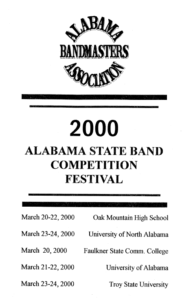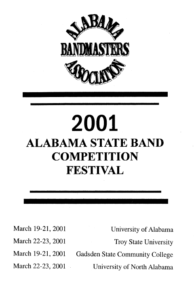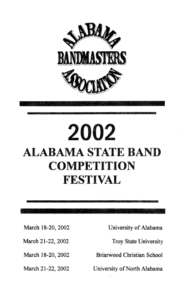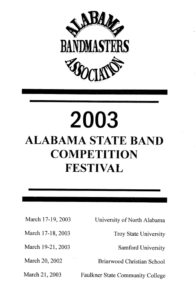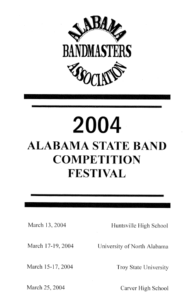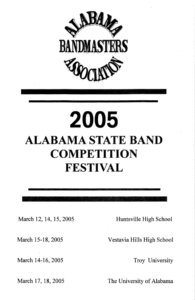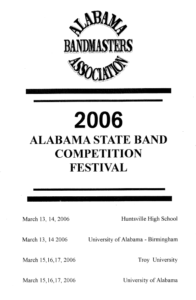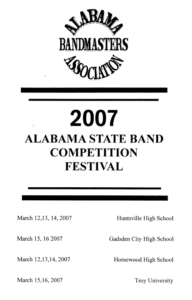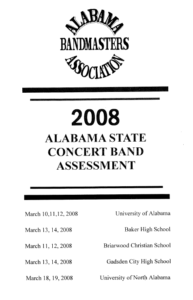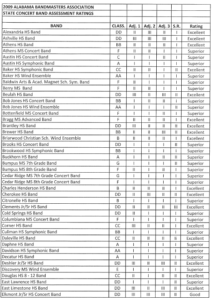1940‘s – 1950‘s – 1960‘s – 1970‘s – 1980‘s – 1990‘s – 2000‘s – 2010‘s – 2020‘s
This decade was where trends from previous years increased. We saw more sites and more judging panels. Overall, a larger percentage of bands were awarded “Superior” ratings than in decades before. This decade would be the last for a two-tiered assessment.
Enjoy this portion of the story of Alabama’s school band movement and the members of the Phi Beta Mu Hall of Fame who helped shape it.
Click the year or the program cover to open a PDF of the printed program.
2000
The five-site, two-panel model continued. Oak Mountain High School served as the central-Alabama location.
The distribution of ratings of the 159 bands is as follows:
- Superior 71 (44%)
- Excellent 79 (50%)
- Good 9 (6%)
- Fair 0 (0%)
2001
This year’s event was held in four locations. One panel of adjudicators listened to bands at Alabama and Troy. Another panel listened to bands at Gadsden State and North Alabama.
The distribution of ratings of the 155 bands is as follows:
- Superior 94 (61%)
- Excellent 56 (36%)
- Good 5 (3%)
- Fair 0 (0%)
2002
This year’s event was held in four locations. One panel of adjudicators listened to bands at Alabama and Troy. Another panel listened to bands at Briarwood Christian School and North Alabama.
The distribution of ratings of the 156 bands is as follows:
- Superior 106 (68%)
- Excellent 49 (31%)
- Good 1 (1%)
- Fair 0 (0%)
2003
This year’s event spread to five locations. One panel of adjudicators listened to bands at North Alabama and Troy. Another panel listened to bands at Briarwood, Samford, and Faulkner.
The distribution of ratings of the 160 bands is as follows:
- Superior 97 (60%)
- Excellent 62 (39%)
- Good 1 (1%)
- Fair 0 (0%)
2004
This year’s event was located at four sites: Huntsville High School, North Alabama, Troy, and Carver (Birmingham) High School. A combination of four different adjudication panels was used.
The distribution of ratings of the 155 bands is as follows:
- Superior 100 (65%)
- Excellent 53 (34%)
- Good 2 (1%)
- Fair 0 (0%)
2005
This year, one panel of judges listened to bands at Huntsville High School and Vestavia Hills High School. A second panel listened to bands at Troy University and the University of Alabama.
The distribution of ratings of the 173 bands is as follows:
- Superior 114 (66%)
- Excellent 56 (32%)
- Good 3 (2%)
- Fair 0 (0%)
2006
This year’s event maintained two panels of adjudicators and four locations. One panel listened to bands at Huntsville High School and Troy University. A second panel listened to bands at the University of Alabama and the University of Alabama at Birmingham. Before this year, adjudicators came from outside the state. Beginning this year, we see a move to a combination of in-state and out-of-state panels.
The distribution of ratings of the 172 bands is as follows:
- Superior 107 (62%)
- Excellent 59 (34%)
- Good 6 (4%)
- Fair 0 (0%)
2007
The classification now expands this year to include “Class DD.” These bands are combinations of junior high and high school grades. Many small schools use students from 7th grade through 12th grade in one band, and the vast majority are younger players. Class DD lets the judges know more about the groups they are hearing and allows directors greater latitude in picking music for their bands.
During this year’s festival, one adjudication panel listened to bands at Huntsville High School and Gadsden City High School. A second panel listened to bands at Homewood High School and Troy University.
The distribution of ratings of the 161 bands is as follows:
- Superior 85 (53%)
- Excellent 61 (38%)
- Good 15 (9%)
- Fair 0 (0%)
2008
This year’s event expanded to five sites. One panel of adjudicators listened to bands at the University of Alabama and Baker High School. A second panel listened to bands at Briarwood Christian School, Gadsden City High School, and the University of North Alabama. This year marks the first time Troy has not hosted a site since the event expanded to multiple locations.
The distribution of ratings of the 157 bands is as follows:
- Superior 86 (55%)
- Excellent 66 (42%)
- Good 5 (3%)
- Fair 0 (0%)
2009
This year’s event is significant for several reasons. The name of the event was changed from being a “competition-festival” to being an “assessment.” It is now the “Alabama Bandmasters Association State Concert Band Assessment.”
This year would also be the last two-tier event with bands qualifying at the district level before moving to the “state” level.
This event has evolved in many ways. In its earlier years, bands performed first at a district festival. Here, they were either “recommended” or “not recommended” to the state level (“Yes” or “No”). Later, ratings were given at the district level: I, II, III, or IV. Some directors would term a “I” at the district festival as a “Superior” rather than seeing it as merely a recommendation to the state level, a recommendation based on the panel’s feeling that with normal continued improvement the band could receive a “Superior” or “Excellent” rating at the state level.
In its earlier days, all bands of a given classification would play back-to-back for the same panel of judges. Eventually, classifications would built each morning and again each afternoon for different panels in four to five locations around the state.
For most of its existence, bands had approximately six weeks to continue to improve between “district” and “state.” Bands had time to even change a program selection if they desired. In later years, the time frame between the two events was very limited.
This year, for the first time since before 1949, there was no formal printed program. What we have this year is a recap sheet. While it shows the names of the participating bands, their classifications, and their ratings, we lose the names of the directors and the program selections, important pieces of information in the history of the organization.
The distribution of ratings of the 136 bands is as follows:
- Superior 83 (61%)
- Excellent 50 (37%)
- Good 3 (2%)
- Fair 0 (0%)
